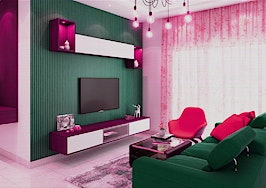
Peter Schravemade
This is the last of a three-part series. Last week, I chatted with Peter Schravemade from BoxBrownie via email about 360 tours. He talked about all things 360-tour-related, covering the history of the technology, recommended cameras to use and best ways to shoot.
This week, we’re discussing virtual renovations and 3D renderings, what they are and how they work. Schravemade also shares a few examples of how virtual renovations could be used to market a property.
(Note: This interview was edited for grammar and style).
I’m working with a builder, what are some options to market properties that are currently under construction or haven’t been built yet?
I see a lot of agents who will go in and pitch to a builder as though it might be the same as winning a standard listing. Aside from the normal things you might bring to demonstrate your skills and experience as an agent, the key difference in working with builders and developers is [you have] to convince them of your ability to market the property(ies) they are creating.
There are multiple conventional ways you can market an existing house, but a house that’s not completed or hasn’t even begun construction will be reliant on the world of renders or CGI (computer-generated imagery). This is where we develop a high-resolution image or even a 360 image of what the property might look like once it is completed.
What is a virtual renovation, and how does it work?
Properties that are under construction can be completed to specification with fairly intensive CGI edits like virtual renovation. Virtual renovation will merge the existing image with CGI to display the completed product.
Virtual renovation is also excellent for removing objections or demonstrating potential in homes that are for sale. It’s especially effective where there is an issue with the property on the market.
What information do I need to provide to create a virtual renovation or computer-generated rendering?
Most renders are created from an AutoCAD file known as the DWG file. Certainly, we have advanced technology now that allows us to generate a render from blueprints or even just a 2D floor plan coupled with an idea of elevation.
Accuracy is always better with the CAD file. CAD files are the most commonly used files of those who draft houses (architects, builders and town planners).
What if I want to change something or multiple options for the same space?
For some time, we have been able to demonstrate that you can swap fixtures and fittings using 2D imagery by simply creating two different renders.
Recently, we began offering a 360 virtual tour hosting section primarily to implement a brand-new development in the world of renders. During the COVID-19 period, we launched 360 virtual tours of a home that doesn’t exist.
Within the 360 virtual tour, we can swap elements of the construction that might be interchangeable (like flooring, kitchens and other fixtures). It means that you could effectively immerse a prospective purchaser right into the middle of a new home or development using 3D-viewing goggles or even on a desktop or mobile device.
This tour features 360 renders of a space, allowing you to toggle furniture on and off. This tour features 360 renders that allow you to switch the actual fixtures and fittings demonstrating different styles.
What are some examples of how virtual renovations could be used to market a property?
One of the biggest issues impacting the sale of already existing properties is that quite often, there’s an objection that might get in the way of successfully drawing an offer from a prospective purchaser.
Great examples are: kitchen colors, dated surfaces like walls, roofs and light fittings. Most common exterior objections include: street appeal, landscaping and garden issues or the absence of a pool.
Virtual renovation is an augmented-reality edit for an image in an effort to ultimately renovate the property, so you can demonstrate the potential of what the property could look like.
Do you recommend putting these photos on MLS?
These edits definitely sit outside the boundaries of what most MLSs will allow (because the property has been altered) and really need to be heavily disclosed. There are some MLSs that will allow this edit with a disclosure. It’s best to check first, and I always encourage disclosure regardless of the MLS stance.
The way I would most effectively use a virtually renovated image sits outside the MLSs. I use the images to remove the objections of purchasers when they’re actually inspecting the property.
For example, a buyer could say: “Yes Mr. Agent, I understand the property is worth the price, but I don’t want the hassle of renovating it.” I would then supply those buyers with a copy of the virtually renovated image (demonstrating what it could look like), and a maintenance or contractor’s quote on what it costs to make the changes. I then encourage the purchasers to make their offer less that dollar value. This removes most objections.
Why should I include a floor plan with my listing? And how do I create one?
The biggest reason you should include a floor plan is because purchasers desperately want one. Floor plans have been the third most-requested element by purchasers in yearly surveys. And they have been for a long time.
Despite the overwhelming evidence of its importance to the purchaser, only 5 percent of MLS listings feature a floor plan. Most recently, selling agents using floor plans have consistently reported them anecdotally to be a massive assist during stay-in-place periods.
There are really three ways to create a floor plan. The first is to find a professional to draw the floor plan for you. The second is if a floor plan exists with the homeowner (remember that appraisers draw these quite often), you can have the floor plans professionally redrawn starting at $24 and working upward in price dependent on whether you want a 2D black-and-white version or a 3D dollhouse version at $32.
The final way is to draw one yourself. Certainly, this seems to be a dying art among agents. The irony is that this is really simple after about two to three attempts. These can be redrawn in the same way as the second option at the same prices.
How long does it take to create a rendering based off of plans/photos?
Renders can be created fairly quickly with improvements in computer hardware. I’ve seen some done in a day, but the reality is, it’s more like a seven to 14-day turnaround.
Most of the time, frames are dependent on the client’s feedback speed. Quite often, there will be several parties that need to proof an image and provide feedback.
When would you recommend using 360 renderings over 2D renderings?
I love the way 360 renders can actually immerse a purchaser in a space. This sells lifestyle and can be instrumental in the purchasers forging an emotional connection with the yet-to-be-constructed property. Whilst the 360 renders are twice the price of a standard 2D render, they are easily twice more effective in demonstrating the space.
How many areas do you recommend for a 360 virtual tour rendering? Do I need to do the whole property?
The amount of areas you do should correlate with your budget and how many times you intend on selling the property. So, for example, if I’m a builder or developer, and I have a condo or a house that I intend to sell multiple times, I would be spending more money on making sure I have comprehensively demonstrated the sales features of that given property.
For most homes, a 2D render of the front of the home can effectively sell the property. For multiple uses, I would be doing a 2D render of the property or development. I would then be doing 360 renders of internal living areas (living area, main bedroom and any featured areas), which might be two to three in total.
Is the virtual staging included with 360 virtual rendering?
By default, most renderers will include it in the standard cost. Certainly, as a rendering service, we will by default be adding it to the internal renders.
Can I mix my edited 360 photos along with 360 renderings in the same tour?
Yes, we’re pretty proud of the fact that we can do this. It’s a very effective way of demonstrating the kitchen renovation that’s about to happen.
How much does it cost to do 2D rendering versus 360 rendering, and how much is the virtual tour to put it all together?
So, 2D renders begin at $280, and 360 renders start at $400, with some optional extras that can cause the cost to rise. A virtual tour with 15 or fewer 360 images is $16. There are very few virtual tours that have more than 15, but we can cater for as many as possible. Floor plans should also accompany properties that have not been created yet ($24-$32).
Can the 360 virtual tour be experienced in VR?
It absolutely can, and I would encourage this. VR goggles start at $10 and can go all the way up to the amazing Occulus Rift VR kits at around $200.
What is the average cost to create a fully immersive marketing experience just off of plans?
This will depend on how many 360 renders you wish to create. Most builders will do a minimum of two. Each render is $400. A 3D floor plan is $32, and the tour is $16, making it a total of $848. Add $400 for each additional 360 render.
What markets and price points are you primarily seeing agents utilizing 360 renderings?
Definitely higher price point properties have a greater budget for these types of edits. Having said that, it could be almost any development at any price.
And if you are selling a lower-budget home or condominium multiple times, we’re seeing clients definitely create the immersive tours to improve the quality of the sale experience and remove objections that might stand in the way of attracting an offer.
Do you have any examples of the actual finished product compared to renderings?
Yes, I do. See below.

Do you have any examples of agents using renderings to market properties at a very high level?
Absolutely, we are always creating renders/CGIs for very high-end New York and Dubai, United Arab Emirates, clients who especially see value in getting the immersive experience to their clients who live all around the globe.
Brandon Doyle is a Realtor at Doyle Real Estate Team — RE/MAX Results in Minneapolis and co-author of Mindset, Methods & Metrics – Winning as a Modern Real Estate Agent. You can follow him on Twitter.







